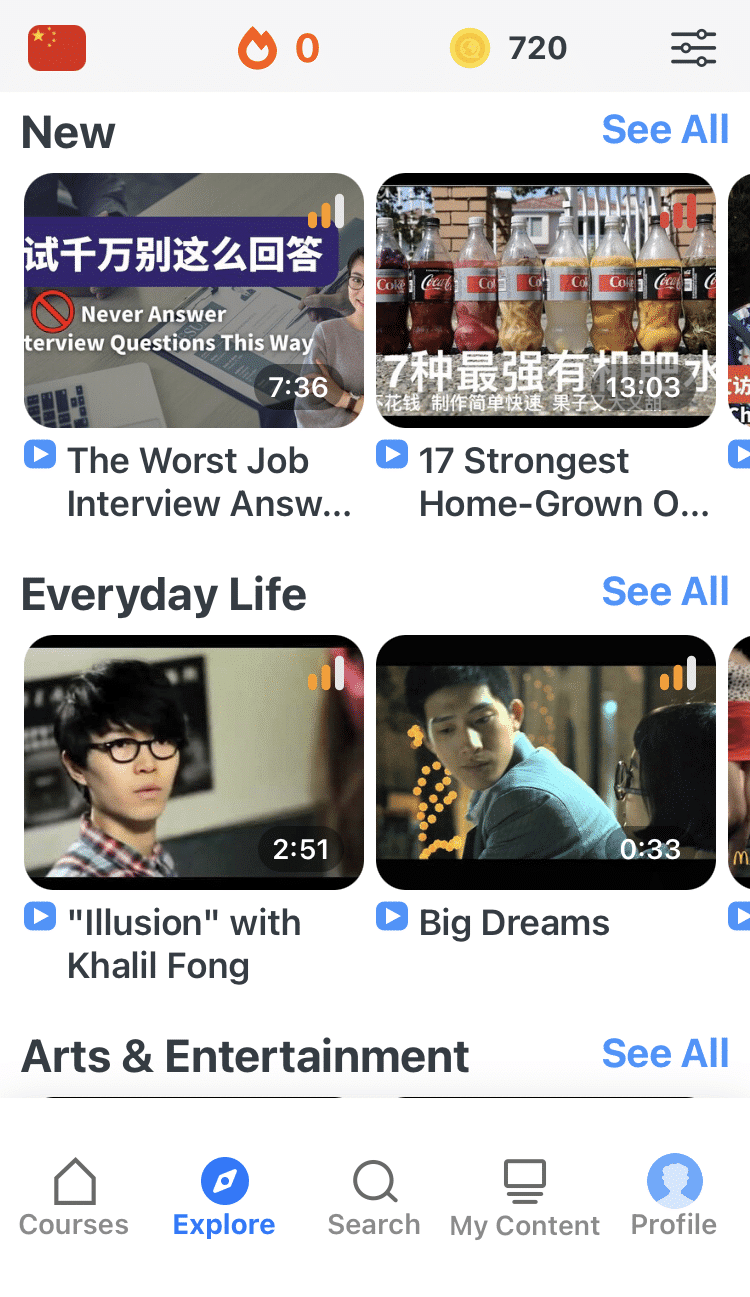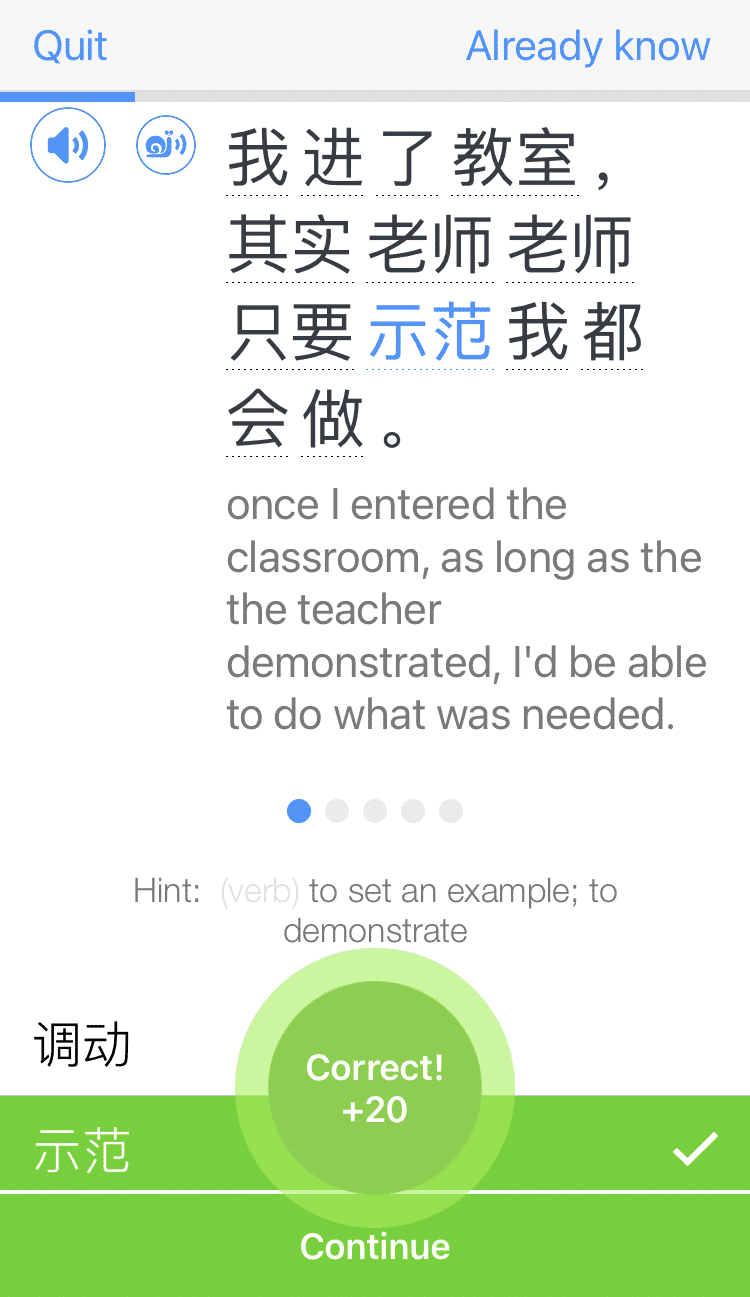Contents
- 1. 一 (yī)
- 2. 人 (rén)
- 3. 十 (shí)
- 4. 山 (shān)
- 5. 大 (dà)
- 6. 小 (xiǎo)
- 7. 口 (kǒu)
- 8. 女 (nǚ)
- 9. 马 (mǎ)
- 10. 工 (gōng)
- 11. 门 (mén)
- 12. 上 (shàng)
- 13. 下 (xià)
- 14. 日 (rì)
- 15. 月 (yuè)
- 16. 水 (shǔi)
- 17. 火 (hǔo)
- 18. 天 (tiān)
- 19. 牛 (niú)
- 20. 木 (mù)
- 21. 开 (kāi)
- 22. 心 (xīn)
- 23. 不 (bù)
- 24. 手 (shǒu)
- 25. 王 (wáng)
- 26. 中 (zhōng)
- 27. 生 (shēng)
- 28. 羊 (yáng)
- 29. 米 (mǐ)
- 30. 男 (nán)
- And One More Thing...
30 Easy Chinese Characters to Start Learning Mandarin

As you begin your Mandarin learning journey, you probably want to ease yourself into the language with the easiest Chinese characters.
Below are some of the most basic, commonly used characters in Chinese, with the least number of character strokes. Because they have so few strokes, these are some of the simplest words to write in Chinese.
You’ll find them easy to remember as well, since some of the characters actually resemble their meaning.
Download: This blog post is available as a convenient and portable PDF that you can take anywhere. Click here to get a copy. (Download)
1. 一 (yī)
Number of strokes: 1
English: One
The character for “one” in Chinese is simply one horizontal stroke.
Incidentally, the characters for two 二 (èr) and three 三 (sān) are also simple horizontal strokes. One, two and three are quite easy to remember, since one is one stroke, two is two strokes, etc.
One in Chinese is used in references to the singular, such as a single person 一个人 (yí gè rén). For example:
我一个人来。 (wǒ yí gè rén lái.) — I came here by myself.
One is also used when ordering or purchasing items. For example:
我要一个。 (wǒ yào yí gè.) — I would like one.
2. 人 (rén)
Number of strokes: 2
English: Man
The Chinese character for “man” is two simple strokes. The character looks like a person with legs apart.
When you put two of these characters together, producing 人人 (rén rén), the meaning is “everyone.” For example:
人人都爱喝可乐。 (rén rén dōu ài hē kě lè.) — Everyone loves drinking soda.
3. 十 (shí)
Number of strokes: 2
English: Ten
Ten in Chinese is a very versatile word. For example, 十分 (shí fēn) means “very much.”
In counting, all the teen digits use ten as the base, like so:
十一 (shí yī) — eleven
十二 (shí èr) — twelve
十三 (shí sān) — thirteen
十四 (shí sì) — fourteen
十五 (shí wǔ) — fifteen
Furthermore, 20 is 二十 (èr shí) or “two tens,” 30 is 三十 (sān shí) “three tens,” 50 is 五十 (wǔ shí) and the pattern continues like this until you reach 90, which is 九十 (jǐu shí).
But just so you know, 100 is not “ten-tens,” it’s 一百 (yī bǎi).
4. 山 (shān)
Number of strokes: 3
English: Mountain
Can you tell that this character looks like a mountain range? Check out the ancient script, and you’ll see that it has a much closer resemblance.
When combined with other characters, it means even more things related to nature and scenery. For example, when combined with the character for “water” or 水 (shǔi), you get 山水 (shān shǔi), which means “landscape.”
Therefore 山水画 (shān shǔi huà) refers to a landscape painting. The character 画 (huà), meaning “painting” or “drawing,” looks like a little picture in a frame!
5. 大 (dà)
Number of strokes: 3
English: Big
See how the character for “big” looks like a person with arms and legs spread wide?
When we combine 大 with another character we just learned (人), we get 大人 (dà rén) meaning “adult,” or literally, “big man.” However, do note that a child isn’t called a “little man.”
You could describe a big mountain as 大山 (dà shān). This, of course, is also the name of famous Chinese-speaking comedian Mark Roswell.
University is called 大学 (dà xué), literally “big school.”
6. 小 (xiǎo)
Number of strokes: 3
English: Small
Since we learned “big,” we have to learn its opposite, 小. Can you guess what “elementary school” is in Chinese? It’s 小学 (xiǎo xué) or “little school.”
Note that 小 only refers to size. When we talk about small amounts, we say 少 (shǎo).
On another note, 小姐 (xiǎo jiě) means “lady.”
7. 口 (kǒu)
Number of strokes: 3
English: Mouth
The character for “mouth” looks just like an opening. Here are some common phrases that use this character:
大口 (dà kǒu) — big mouthful
出口 (chū kǒu) — exit
人口 (rén kǒu) — population
山口 (shān kǒu) — mountain pass
8. 女 (nǚ)
Number of strokes: 3
English: Female
This character kind of looks like a lady with her legs crossed. Check out its interesting evolution throughout history. Here are two examples of how to use this character:
美女 (měi nǚ) — pretty girl
少女 (shào nǚ) — young lady
9. 马 (mǎ)
Number of strokes: 3
English: Horse
The horse character resembles an animal with running legs and a long neck. It went through several iterations throughout history. Here are two more common uses of this character:
马上 (mǎ shàng) — immediately
人马 (rén mǎ) — troops, literally “men and horses”
10. 工 (gōng)
Number of strokes: 3
English: Work
This I-beam character appears in many work-related terms as well. Here’s where you might see it:
工作 (gōng zuò) — job
工人 (gōng rén) — worker
木工 (mù gōng) — woodwork / carpentry
11. 门 (mén)
Number of strokes: 3
English: Door
This character does bear a striking resemblance to a doorway, doesn’t it? Here are a couple more uses of this character:
门口 (mén kǒu) — doorway
开门 (kāi mén) — open the door
12. 上 (shàng)
Number of strokes: 3
English: Up
Three strokes make up this character that looks like it’s pointing up. This character also refers to attending something or going somewhere. Here’s how we use it:
上课 (shàng kè) — go to class
上班 (shàng bān) — go to work
晚上 (wǎn shàng) — in the evening
早上 (zǎo shàng) — in the morning
爱上 (ài shàng) — fall in love; note that in Chinese, we don’t “fall” in love with someone, we love “upon” someone!
上车 (shàng chē) — get in the car
13. 下 (xià)
Number of strokes: 3
English: Down
This simple character looks like a downward arrow. It also refers to leaving or getting off someplace.
下班 (xià bān) — get off work
下课 (xià kè) — get off class
下车 (xià chē) — get out of the car
14. 日 (rì)
Number of strokes: 4
English: Sun
The character for “sun” looks like a box with a line in the middle. It’s supposed to approximate the image of the sun. You might have to use a little imagination, but in the ancient bronze script, this character was more circular like the sun.
日 not only refers to the Earth’s source of light, but it also means “day.” It’s used when talking about dates, e.g. 7日 is the seventh day of whatever month you’re talking about. If you put two sun characters together (日日), it means “every day.”
15. 月 (yuè)
Number of strokes: 4
English: Moon
The character for “moon” originally resembled a crescent. If you look at the oracle bone script, you’ll see what I mean.
月 not only refers to the nightly crescent, but it also means “month.” For example, 8月 7日 is how you’d write “August 7.”
You can write all the months in Chinese simply by putting a numeral (or the appropriate Chinese character if you like—either way works) in front of 月. Here are the names for January through March:
1月
2月
3月
Too easy, right?
16. 水 (shǔi)
Number of strokes: 4
English: Water
The character for “water” resembles a drip with some splashes. It was much more watery-looking thousands of years ago.
To make use of another character we already learned (一), “one glass of water” is 一杯水 (yì bēi shǔi). To ask for a glass of water, you could say:
请给我一杯水。 (qǐng gěi wǒ yī bēi shǔi.) — Please give me a glass of water.
17. 火 (hǔo)
Number of strokes: 4
English: Fire
Check out this flaming character’s evolution from the bone script version. Very cool.
One place you might see 火 is in recipes because 大火 (dà hǔo) is “big flame” and 小火 (xiǎo hǔo) is “small flame.” These will tell you the heat levels for cooking!
Here are a few more ways to use the character:
火车 (hǔo chē) — train
山火 (shān hǔo) — forest fire
18. 天 (tiān)
Number of strokes: 4
English: Sky
Notice how the shape of this character points upwards, towards the sky. Two of these characters together 天天 mean “every day” as well.
The four seasons are written as:
春天 (chūn tiān) — spring
夏天 (xià tiān) — summer
秋天 (qīu tiān) — fall
冬天 (dōng tiān) — winter
There’s also:
今天 (jīn tiān) — today
昨天 (zuó tiān) — yesterday
明天 (míng tiān) — tomorrow
19. 牛 (niú)
Number of strokes: 4
English: Cow
This character looks like an animal with horns. Here are a couple of ways we use this character:
牛肉 (niú ròu) — beef
太牛了! (tài niú le!) — awesome; we’re not sure what cows have to do with awesomeness, but maybe it’s kind of like “holy cow!” in English.
20. 木 (mù)
Number of strokes: 4
English: Wood
This nature-associated character resembles a tree. Here are two examples of associated vocabulary:
木瓜 (mù guā) — papaya
木琴 (mù qín) — xylophone
21. 开 (kāi)
Number of strokes: 4
English: Open
This word can also mean “to start.” We use this character in these ways:
开刀 (kāi dāo) — surgery
开工 (kāi gōng) — start work
开口 (kāi kǒu) — speak up
22. 心 (xīn)
Number of strokes: 4
English: Heart
We’re not totally sure, but perhaps this character looks a little like the organ it refers to. What do you think? Here’s how to use this character:
小心 (xiǎo xīn) — be careful
开心 (kāi xīn) — happy
23. 不 (bù)
Number of strokes: 4
English: No
Although this character means “no,” we don’t usually use it by itself. We usually say 不是 (bú shì) for “no” and “not correct” or 不好 (bù hǎo) for “no” or “not good.”
不少 (bù shǎo) literally translates to “not few,” and so in other words means “a lot.”
24. 手 (shǒu)
Number of strokes: 4
English: Hand
Can you guess how this character resembles its meaning? Check out the lines in the palm of your hand! Here are more ways to use this character:
手工 (shǒu gōng) — handicraft
一手 (yī shǒu) — single-handedly / by oneself
水手 (shǔi shǒu) — sailor
25. 王 (wáng)
Number of strokes: 4
English: King
Wang (王) is a popular last name; for example 王力宏 (wáng lì hóng), or Leehom Wang, is the name of a popular singer and actor.
There’s also 王子 (wáng zǐ), which means “prince.”
26. 中 (zhōng)
Number of strokes: 4
English: Center
This is an important character because it’s part of China’s name. It also looks like what it means: a line through the center of something. You’ll see this character used in these ways, among others:
中国 (zhōng gúo) — China; literally meaning “Middle Kingdom”
中文 (zhōng wén) — Chinese
中午 (zhōng wǔ) — noon
中学 (zhōng xué) — middle school
27. 生 (shēng)
Number of strokes: 5
English: Birth
The word “birth” also refers to life and the start of something. Here are some of the many ways to use it:
生日 (shēng rì) — birthday
一生 (yì shēng) — one’s whole life, lifetime
先生 (xiān shēng) — mister; e.g. 王先生 (wáng xiān shēng) Mr. Wang
出生 (chū shēng) — be born
生气 (shēng qì) — get angry
28. 羊 (yáng)
Number of strokes: 6
English: Sheep
Do you think this character looks like an animal with antlers? Here’s how we use this character:
山羊 (shān yáng) — mountain sheep/goat
羊毛 (yáng máo) — fleece
29. 米 (mǐ)
Number of strokes: 6
English: Rice
Now for the word that refers to the food staple and the Chinese cultural icon! Here are more cases of the character for “rice”:
玉米 (yù mǐ) — corn
白米 (bái mǐ) — white rice or refined rice for eating
30. 男 (nán)
Number of strokes: 7
English: Boy
The character for “boy” is actually the combination of 田 (tián) for “farm” and 力 (lì) for “work,” referring to how traditionally men worked the land. You’ll see this character on the door of public washrooms.
Here are a couple more instances using this character:
男人 (nán rén) — man
男友 (nán yǒu) — boyfriend
This solid list of easy Chinese characters should get you well on your way to becoming a language superstar! Then, you can take it a step further by using an immersive learning program like FluentU, where you can see new vocabulary written in the subtitles and used naturally in short videos.
FluentU takes authentic videos—like music videos, movie trailers, news and inspiring talks—and turns them into personalized language learning lessons.
You can try FluentU for free for 2 weeks. Check out the website or download the iOS app or Android app.
P.S. Click here to take advantage of our current sale! (Expires at the end of this month.)
We wish you the best of luck on your Chinese studying journey.
Download: This blog post is available as a convenient and portable PDF that you can take anywhere. Click here to get a copy. (Download)
And One More Thing...
If you want to continue learning Chinese with interactive and authentic Chinese content, then you'll love FluentU.
FluentU naturally eases you into learning Chinese language. Native Chinese content comes within reach, and you'll learn Chinese as it's spoken in real life.
FluentU has a wide range of contemporary videos—like dramas, TV shows, commercials and music videos.
FluentU brings these native Chinese videos within reach via interactive captions. You can tap on any word to instantly look it up. All words have carefully written definitions and examples that will help you understand how a word is used. Tap to add words you'd like to review to a vocab list.
FluentU's Learn Mode turns every video into a language learning lesson. You can always swipe left or right to see more examples for the word you're learning.
The best part is that FluentU always keeps track of your vocabulary. It customizes quizzes to focus on areas that need attention and reminds you when it’s time to review what you’ve learned. You have a 100% personalized experience.
Start using the FluentU website on your computer or tablet or, better yet, download the FluentU app from the iTunes or Google Play store. Click here to take advantage of our current sale! (Expires at the end of this month.)











